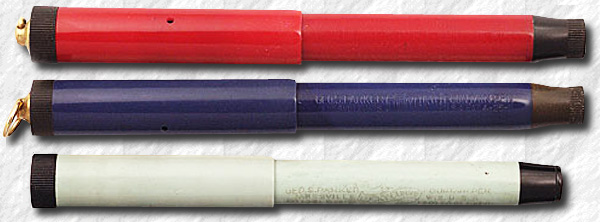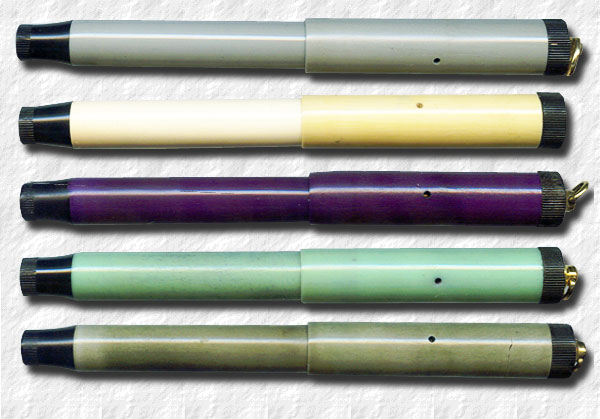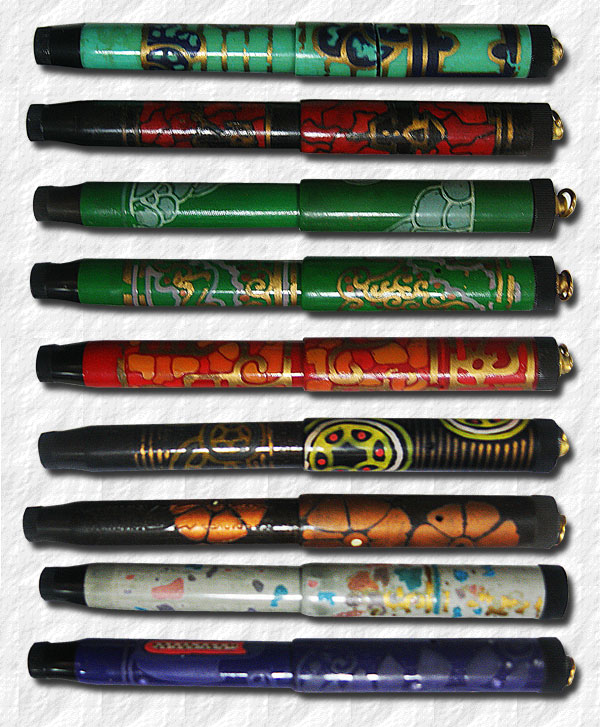
| parkerpens.net |
| PARKERCOLLECTOR.COM |
 |
Three fantastic Ivorines from around 1920. |
It wasn't widely advertised, although Parker in one november 1921 ad boasted that it was selling like "wildfire", The truth was that Parker had trouble obtaining the raw material. Since casein wasn't readily available in the US it was being shipped all the way from France. A somewhat risky endevour since it was so sensitive to moist storing. The ad continues to explain that 1 200 pounds of the Ivorine pen material had arrived in New York on October 23rd 1921 on it's trip from Bordeaux. It was destined to be made into Parker "Safety sealed, self filling pens". It is possible that World War I hindered the export from Europe. David Nishimura refers to Parker ads in turn referring to the interruption of Ivorine availability due to the war. He believes that the source of the material prior to that interruption was Germany rather than France. |
Later colours included: New colours were introduced before christmas 1921: |
 Image © and courtesy of Itshak "Tsachi" Mitsenmacher |
Five wonderful Ivorines from the 1920's. |
It's quite possible that many of the mentioned colours were the same only with different names used in the advertising. |
There has been much controversy regarding which pens are casein and which are not. Pen collector David Nishimura has handled many true casein pens and devised an easy test to see if the pen is really casein or "just ordinary" plastic. The only way to know for sure is to scrape a small amount of plastic from the inside of the pen and drip some acetone on it. Acetone will desolve celluloid but not casein (which also makes them difficult to repair). He argues that most pens in collector's hands believed to be casein are in fact celluloid, be that colourful ones. |
 Image courtesy of The Parker Pen Company Archives. |
Hand painted Ivorines from the 1920's. |
Image courtesy of "Skybird". |
Parker Ivorine ad, 1921. |
© 1995-2019 Tony Fischier and The Parker Pen Company®/Sanford Ecriture.
This page is in no way sponsored by or created by the Parker Pen Company®. All opinions, views, and thoughts expressed herein are expressly the authors, and in no way reflect the opinions, views, or thoughts of the Parker Pen Company®/Sanford Ecriture. All logos and/or images on these pages are © Copyright of Parker Pen Company®Sanford Ecritureunless otherwise stated and is reprinted by kind permission. If You feel that Your copyright has been violated please contact the WEBMASTER.
Everything on this website is copyrighted by law and can not be used without written permission from the author, Tony Fischier. You may however use the information as reference material and although it is forbidden to make digital copies or reproductions it may be physically printed for personal use, which does not include use on other web pages or in advertising. You may however quote parts of the content of this website, digitally or physically, providing that the source and author is clearly stated, together with the copyright information. In the US referred to as Fair use. If you use any information on this site, add a link.
Feel free to donate a small sum through Paypal to help this site to stay online. Acknowledgements.
Parkercollector.com in translated versions

